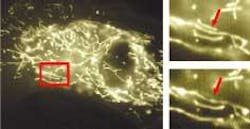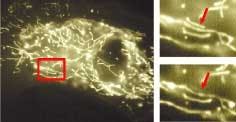Femtosecond pulses permit surgery within cells
Just as the focused beam of an ultrafast laser can create or alter micron-scale features in transparent inorganic materials such as glass, it can be used to microscopically modify transparent organic materials as well. In both cases, the brevity of the pulse causes ablation or dissociation of a material on a time scale short enough that thermal effects in the surrounding material are minimized. In the case of organic substances, this is especially important if microsurgery, rather than a cooked specimen, is the intended result.
Led by Eric Mazur, researchers at Harvard University are using femtosecond pulses to alter individual features within living cells. In one example, they eliminate a single mitochondrion while leaving surrounding structures intact (see figure). "The mitochondrion was chosen because of its localized nature and close proximity to other mitochondria," says Samuel Hue-Kay Chung, one of the researchers. "By demonstrating that it is possible to cut a single mitochondria, it is clear that this technique can be applied to most other subcellular organelles or parts." For example, Chung is using femtosecond pulses to ablate brain-cell extensions in Caenorhabditis elegans (a nematode with a simple nervous system that is relevant to those of more-complex organisms). Individual axons can be cut without killing the nerve cells or disrupting the surrounding tissue, earning the technique the moniker "nanoneurosurgery."
In the setup, a Ti:sapphire laser emits 100-fs pulses at a 1-kHz rate and an 800-nm wavelength, with pulse energies ranging from 2 to 8 nJ. A 63× microscope objective with a numerical aperture of 1.4 produces a diffraction-limited 800-nm spot, which results in a transverse damage area less than a micron across, says Chung. Several microsurgical techniques have been used, including translation of the sample as the laser irradiates it (yielding a linear cut) and keeping the laser beam in one position (yielding a single puncture).
While the removal of a mitochondrion serves as an example of the precision of the technique, femtosecond-pulse laser microsurgery is already being practically applied. "There is a host of cell and developmental biology questions that can benefit from our nanosurgery tool," says Chung. "For instance, Howard Berg in the biology department at Harvard, who examines the flagellar motor of Escherichia coli, is collaborating with us to cut open a cell for access to the inside of the flagellar motor. The motor is fixed in the cell membrane, and previous experiments have only accessed the motor from the outside of the cell. We believe that we can hold the cell membrane open for biochemical manipulation within the cell."

